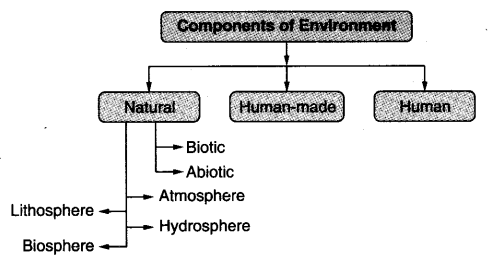Notes For All Chapters Geography Class 7
Environment
Nature, place, people, things, etc. that surround the living organisms make the environment. The environment can broadly be classified into the natural and human environment. It is a combination of both natural as well as man-made phenomena.
The natural environment comprises biotic (plants and animals) and abiotic-conditions(land, water, air, etc.), whereas the man-made phenomena comprise the activities and interactions among human beings (roads, bridges, etc.).
Natural Environment
(i) Land, water, air, plants and animals comprise the natural environment.
(ii) Lithosphere, atmosphere, hydrosphere and biosphere are the four domains of the natural environment.
(iii) The lithosphere is the solid crust or the outermost layer of the earth where we live. It contains landforms like mountains, plateaus, plains and valleys.
(iv) The hydrosphere is the domain of water. It comprises water bodies like rivers, lakes, seas, oceans, etc.
(v) The atmosphere is the thin layer of air that surrounds the earth. It protects us from the harmful rays and scorching heat of the sun.
(vi) The biosphere is a narrow zone of the earth where land, water and air interact with each other to support life.
What is Ecosystem?
(i) The relation between the living organisms as well as the relation between the organisms and their surrounding form the ecosystem.
(ii) There could be an ecosystem of large rainforest, grassland, desert, mountains, lake, river, ocean and even a small pond.
Human Environment
(i) Human beings interact with the environment and modify it according to their needs.
(ii) Early humans adapted themselves to their natural surroundings.
(iii) With time, humans learnt to grow new things, domesticate animals and lead a settled life.
(iv) The industrial revolution, transportation and information revolution made communication easier and speedy across the world.
(v) Man is destroying the environment through deforestation, industrialisation, etc.
The environment in our basic life support system. It provides the air we breathe, the water we drink, the food we eat and the place where we live. Thus, the environment is the most important aspect of our life.
The natural environment consists of land, water, air, plants and animals. It refers to both biotic and abiotic conditions existing on the earth.
While biotic refers to the world of living organisms, such as plants and animals, abiotic refers to the world of non-living elements, such as land.
The human environment refers to the activities, creations and interactions among human beings.
Domains of environment—Lithosphere, hydrosphere, atmosphere and biosphere.
The lithosphere is the solid portion of the earth where we live. It is the domain that provides us forests, grasslands for grazing, land for agriculture and human settlements. It is where we find several minerals.
Hydrosphere refers to the water bodies like rivers, lakes, seas, oceans, etc. that exist on the earth.
The atmosphere is the thin layer of air that surrounds the earth. It protects us from the harmful rays and searching heat of the Sun. It consists of gases, dust and water vapour.
Biosphere or the living world is comprised of plant and animal life. It is a narrow zone of the earth where land, water and air interact with each other to support life.
The relation between the living organisms as well as the relation between the organisms and their surroundings form an ecosystem.
An ecosystem can be found in lakes, mountains, oceans, pond, etc.
Human beings modify the natural environment as per their needs.
Environment: The place, people, things and nature that surround any living organism is called the environment.
Biotic: It refers to the world of living organisms, such as plants and animals.
Abiotic: It refers to the world of non-living elements such as land.
Lithosphere: It is the solid crust or the hard top layer of the earth.
Hydrosphere: It refers to the water bodies like rivers, lakes, seas, oceans, etc. on the earth.
Atmosphere: It is the thin layer of air that surrounds the earth.
Ecosystem: The relation between the living organisms, as well as the relation between the organisms and their surroundings, form an ecosystem.
Barter system: A trade in which goods are exchanged without the use of money.


beautiful